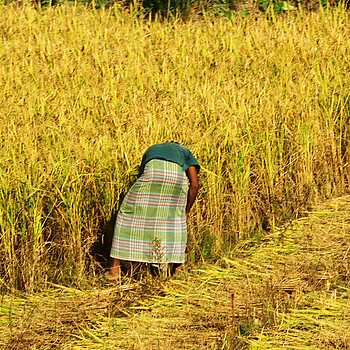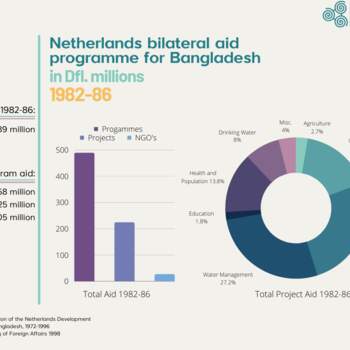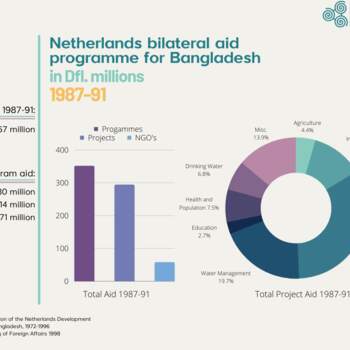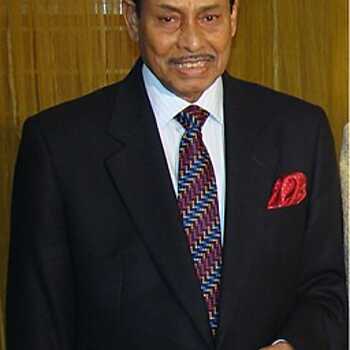Political context
On 30 May 1982, three teams of army officers attacked Chittagong Circuit House where Ziaur Rahman was sleeping. The members of the attacking team were all commissioned officers. Colonel Matiur Rahman shot Zia from close range and was killed while trying to escape. After the assassination, Hussein Muhammad Ershad, the Chief of Army Staff, remained loyal to the government and ordered the army to suppress the coup attempt of Rahman’s associates.
Following Ziaur Rahman’s death, Bangladesh's vice-president, Justice Abdus Sattar, became Acting President. He was elected in a popular vote in December 1981 but was deposed on 24 March 1982 in a bloodless coup led by Ershad. He declared himself President in 1983 and subsequently won the controversial 1986 Bangladeshi presidential elections. His regime can be regarded as a military dictatorship. He served in the Presidential office until 1990, when he was forced to resign following a popular pro-democracy mass uprising led by Khaleda Zia and Sheikh Hasina. Ershad founded the Jatiya Party in 1986.
During his tenure Ershad pursued devolution reforms, privatization of the nationalized industries, expansion of the national highway system and the founding of the South Asian Association for Regional Cooperation. He committed his nation’s forces as an ally of the United States in the Gulf War. In 1989, Ershad pushed parliament to make Islam the state religion, in a sharp departure from Bangladesh's original secular constitution. Ershad was awarded the United Nations Population Award in 1987 for his contributions to population and environmental issues.
The political history of Bangladesh’s first twenty years can be broadly divided into two eras: the era of populist authoritarianism (1972-1975) and the era of military dominated rule (1975-1990). After 15 years of the presidential system, the country returned to a parliamentary system of government in 1991.
Situation in Bangladesh in the 1980s
The 1980s in Bangladesh were characterized by economic hardship, natural disasters and military dictatorship. Ershad ruled almost throughout the decade. Infrastructure development was slow, but there was notable progress in local government administration, population control and NGO-led microfinance activities that boosted the rural economy.
Bangladesh's GDP grew from US$ 28.6 billion in 1980 to US$ 40.2 billion in 1989 (in 2010 constant dollars), representing annual growth of 3.4%, down from 4.4% in the 1970s. The contributions to the GDP of the agricultural sector (32%), industry (20%) and services (47%) remained more or less constant. By the end of the decade, the government's recurrent expenditures exceeded the development budget.
Relationship with the Netherlands
The main component of the Netherlands' relationship with Bangladesh continued to be the provision of financial and technical aid. There was commercial traffic as well, but still at a relatively low level and with a negative balance for Bangladesh. In the ten-year period from 1981 to 1990, total imports from the Netherlands came to Dfl. 1184 million (€ 537 million), while exports amounted to Dfl. 532 million (€ 241 million). The main items imported were machinery, chemicals, vegetables, and oils. Exports to the Netherlands mainly comprised jute, leather, handicrafts, and frozen fish. The negative trade balance would be completely reversed in the 1990s, with sharp increases in Bangladesh's exports and a decline in imports from the Netherlands. Bangladesh established a trading house in Rotterdam, which was operational from 1979 to 1982 with a subsidy from the Netherlands Centre for Promotion of Imports from Developing Countries (CBI).
Overview of aid
The total value of aid from 1982 to 1991 was Dfl. 1406 million (€ 638 million) divided between:
- program aid (57%)
- project aid (37%)
- assistance through NGOs (6%)
Program aid went almost exclusively to industry and agriculture. Project aid went to:
- transport (30%)
- water management (23%)
- industry/energy (14%)
- health and population (10%)
- drinking water (7%)
- agriculture (4%)
- education (2%)
- miscellaneous (10%)
Annual consultations
The most significant events in the aid relationship were the annual bilateral consultations. The following account of consultations in early 1980 gives an impression of the content of these meetings.
On February 25 through 28, 1980, the annual consultation took place in Dacca. The discussion covered the programming and utilization of funds made available in previous years, procedural matters and proposals concerning the bilateral co-operation programme for 1980, to a total amount of Dfl. 94 mln. (€ 43 mln.) consisting of a partially untied grant of Dfl. 78 mln. (€ 35 mln) for financial assistance and an untied grant of Dfl. 16 mln (€ 7 mln.) for technical assistance. The partially untied grant is to be used for procurement from the Netherlands or developing countries, including Bangladesh. Part of this grant can be allocated to meet local costs. In addition to the yearly bilateral allocation in 1980 a grant amounting to Dfl. 10 mln. (€ 4.5 mln.) has been allocated for the procurement of food grains.
In total, including available funds from previous years an amount of Dfl. 86.8 mln. (€ 39.5) was allocated under financial aid and Dfl. 17 mln. (€ 7.7 mln.) under technical aid.
Second Five-Year Plan (1980-1985)
The Bangladesh delegation reviewed the major policy guidelines of the coming Second Five-Year Plan (1980-1985). In this Second Five-Year Plan top priority will be given to the rural and human resources development. The Plan aims at self-sufficiency in agricultural production by 1985, especially through vastly increased irrigation facilities and agricultural inputs. In connection with this objective, it was stated that fertilizer consumption would double.
The Plan further emphasizes population policy guidelines. In this respect the Bangladesh delegation made reference to the three elements of population policy, i.e. education and training aimed at the eradication of illiteracy, the Population Programme intended to reduce fertility rates and the Programme for Women promoting female emancipation with particular emphasis on an increasing role for women within the national economy. The Bangladesh delegation stated that a considerable increase in the net capital flow would be needed in order to attain the targets set in the Second Five Year Plan.
Recent Dutch perspectives on development cooperation
The Netherlands delegation gave an outline of recent thinking in the Netherlands concerning bilateral development co-operation. It emphasized the point that the Netherlands view the improvement of the plight of the poorest population in developing countries as a priority goal, the other major objectives being the promotion of self-reliance of the developing countries.
One method under intense review is that the Netherlands Government, in close collaboration with the Government of the developing country, in addition to the traditional activities, select one or more particular socio-economic sectors, population groups, or geographical areas, on which particular attention will be focussed for a specific number of years. Under these conditions, an assured, long term development strategy for the said sectors, groups or areas and the activities to be undertaken in this frame of reference, could be worked out gradually and more thoroughly.
Country policy plans
From 1985 to 1995, the Netherlands formulated three country policy plans. In the 1985-1988 plan the aid was concentrated on two priority sectors: industry and rural development. The latter included a wide variety of activities such as food production, and food security (provision of fertilizer and construction of food storage facilities), water management and social infrastructure (population and health, drinking water). Industrial development included support for natural gas exploitation as well as the textile and chemical industries. Support for inland water transport was seen as a part of industrial development. The country plan mentions that attention will be given to the position of women, by expansion of activities specifically aimed towards women and by mainstreaming gender aspects in the priority sectors.
Dependence on aid
Total net Official Development Assistance (ODA) to Bangladesh in the ten years from 1980 to 1989 amounted to US$ 13,634 mln., including a little over 4% in Dutch assistance. Bangladesh continued to be heavily dependent on aid.
Rehman Sobhan, Research Director of the Bangladesh Institute for Development Studies, analyses the consequences of being dependent on aid in his book The Crisis of External Dependence (1982) as follows: “Bangladesh policy makers continue to wait upon decisions in Washington, London, Tokyo, Bonn and Paris before they formulate their annual development budgets, announce an import policy, formulate a food policy or even decide how many children should be born. The decision makers of the developed world hold the lifeline of any regime in Bangladesh in their hands and can visit havoc on the life of a country in a way which was inconceivable two decades ago. The sovereignty of the Bangladesh nation state, in its prevailing social configuration, is therefore likely to remain a polite fiction which is perpetuated by the courtesy of the donors as long as Bangladesh does not challenge their current strategic assumptions and ideological preconceptions.”
Sources and Read More:
Sobhan, Rehman (1982). The Crisis of External Dependence.
IOB (1998). Bangladesh Evaluation of the Netherlands Development Programme with Bangladesh.



